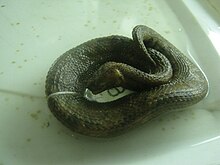| Trachyboa boulengeri | |
|---|---|

| |
|
Scientific classification
| |
| Domain: | Eukaryota |
| Kingdom: | Animalia |
| Phylum: | Chordata |
| Class: | Reptilia |
| Order: | Squamata |
| Suborder: | Serpentes |
| Family: | Tropidophiidae |
| Genus: | Trachyboa |
| Species: | T. boulengeri
|
| Binomial name | |
| Trachyboa boulengeri
Peracca, 1910
| |
Trachyboa boulengeri, commonly known as the northern eyelash boa, is a species of nonvenomous snake in the family Tropidophiidae. [2] The species is endemic to Central America. [3]
Etymology
The specific name, boulengeri, is in honor of Belgian-born British herpetologist George Albert Boulenger. [4]
Geographic range
T. boulengeri is found in Colombia, western Ecuador, [5] and Panama. [6]
Habitat
The preferred natural habitat of T. boulengeri is evergreen lowland forest, [7] at altitudes from sea level to 1,000 m (3,300 ft). [1] It is usually found near freshwater flooded areas, irrigation ditches, and rivers. [1]
Diet
T. boulengeri preys on frogs and fishes. [7]
Reproduction
T. boulengeri is viviparous. [6]
References
- ^ a b c Ibáñez, R.; Jaramillo, C.; Rivas, G.; Gutiérrez-Cárdenas, P.; Yánez-Muñoz, M.; Cisneros-Heredia, D.F. (2019). "Trachyboa boulengeri". IUCN Red List of Threatened Species. 2019: e.T203214A2762365. doi: 10.2305/IUCN.UK.2019-2.RLTS.T203214A2762365.en. Retrieved 19 November 2021.
- ^ McDiarmid RW, Campbell JA, Touré T (1999). Snake Species of the World: A Taxonomic and Geographic Reference, Volume 1. Washington, District of Columbia: Herpetologists' League. 511 pp. ISBN 1-893777-00-6 (series). ISBN 1-893777-01-4 (volume).
- ^ "Trachyboa". Integrated Taxonomic Information System. Retrieved 29 August 2007.
- ^ Beolens B, Watkins M, Grayson M (2011). The Eponym Dictionary of Reptiles. Baltimore: Johns Hopkins University Press. xiii + 296 pp. ISBN 978-1-4214-0135-5. (Trachyboa boulengeri, p. 34).
- ^ Freiberg M (1982). Snakes of South America. Hong Kong: T.F.H. Publications. 189 pp. ISBN 0-87666-912-7. (Trachyboa boulengeri, p. 88).
- ^ a b Species Trachyboa boulengeri at The Reptile Database www.reptile-database.org.
- ^ a b Dwyer Q, Arteaga A, Barrio-Amorós CL, Flagle A (2018). "Trachyboa boulengeri. Diet". Herpetological Review 49 (2): 359–360.
Further reading
- Lehmann HD (1970). "Beobachtungen bei der Haltung und Aufzucht von Trachyboa boulengeri (Serpentes, Boidae) [= Observations on the Keeping and Rearing of Trachyboa boulengeri (Serpentes, Boidae)]". Salamandra 6: (1–2): 32–42, 6 figures. (in German, with an abstract in English, and bilingual captions).
- Peracca MG (1910). "Descrizione di alcune nuove specie di ofidii del Museo Zoologico della R.a Università di Napoli ". Annuario del Museo Zoologico della R[egi].a Università di Napoli, Series 3, 12: 1–3. (Trachyboa boulengeri, new species). (in Italian).
| Trachyboa boulengeri | |
|---|---|

| |
|
Scientific classification
| |
| Domain: | Eukaryota |
| Kingdom: | Animalia |
| Phylum: | Chordata |
| Class: | Reptilia |
| Order: | Squamata |
| Suborder: | Serpentes |
| Family: | Tropidophiidae |
| Genus: | Trachyboa |
| Species: | T. boulengeri
|
| Binomial name | |
| Trachyboa boulengeri
Peracca, 1910
| |
Trachyboa boulengeri, commonly known as the northern eyelash boa, is a species of nonvenomous snake in the family Tropidophiidae. [2] The species is endemic to Central America. [3]
Etymology
The specific name, boulengeri, is in honor of Belgian-born British herpetologist George Albert Boulenger. [4]
Geographic range
T. boulengeri is found in Colombia, western Ecuador, [5] and Panama. [6]
Habitat
The preferred natural habitat of T. boulengeri is evergreen lowland forest, [7] at altitudes from sea level to 1,000 m (3,300 ft). [1] It is usually found near freshwater flooded areas, irrigation ditches, and rivers. [1]
Diet
T. boulengeri preys on frogs and fishes. [7]
Reproduction
T. boulengeri is viviparous. [6]
References
- ^ a b c Ibáñez, R.; Jaramillo, C.; Rivas, G.; Gutiérrez-Cárdenas, P.; Yánez-Muñoz, M.; Cisneros-Heredia, D.F. (2019). "Trachyboa boulengeri". IUCN Red List of Threatened Species. 2019: e.T203214A2762365. doi: 10.2305/IUCN.UK.2019-2.RLTS.T203214A2762365.en. Retrieved 19 November 2021.
- ^ McDiarmid RW, Campbell JA, Touré T (1999). Snake Species of the World: A Taxonomic and Geographic Reference, Volume 1. Washington, District of Columbia: Herpetologists' League. 511 pp. ISBN 1-893777-00-6 (series). ISBN 1-893777-01-4 (volume).
- ^ "Trachyboa". Integrated Taxonomic Information System. Retrieved 29 August 2007.
- ^ Beolens B, Watkins M, Grayson M (2011). The Eponym Dictionary of Reptiles. Baltimore: Johns Hopkins University Press. xiii + 296 pp. ISBN 978-1-4214-0135-5. (Trachyboa boulengeri, p. 34).
- ^ Freiberg M (1982). Snakes of South America. Hong Kong: T.F.H. Publications. 189 pp. ISBN 0-87666-912-7. (Trachyboa boulengeri, p. 88).
- ^ a b Species Trachyboa boulengeri at The Reptile Database www.reptile-database.org.
- ^ a b Dwyer Q, Arteaga A, Barrio-Amorós CL, Flagle A (2018). "Trachyboa boulengeri. Diet". Herpetological Review 49 (2): 359–360.
Further reading
- Lehmann HD (1970). "Beobachtungen bei der Haltung und Aufzucht von Trachyboa boulengeri (Serpentes, Boidae) [= Observations on the Keeping and Rearing of Trachyboa boulengeri (Serpentes, Boidae)]". Salamandra 6: (1–2): 32–42, 6 figures. (in German, with an abstract in English, and bilingual captions).
- Peracca MG (1910). "Descrizione di alcune nuove specie di ofidii del Museo Zoologico della R.a Università di Napoli ". Annuario del Museo Zoologico della R[egi].a Università di Napoli, Series 3, 12: 1–3. (Trachyboa boulengeri, new species). (in Italian).
